We love eating at street-side vendors and all have our favorite ones here in China.
But here’s a list of some of the less appetizing street foods you might not have seen:
1. Deep Fried Massive Spiders(油炸大蜘蛛 yóu zhá dà zhī zhū )
These bad boys were spotted in Hangzhou and were so massive that I was scared to even take a photo of them!
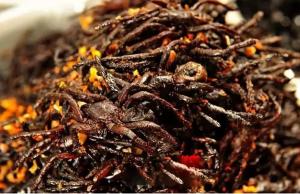
The efficacy of spiders:relieve rheumatic pains, drastically remove blood stasis and resolve static blood, treatssnakebites, stubborn dermatitis, furuncle, anal fistulas, scrofula, and sore-throats.
2. Duck Heads(鸭头 yā tóu)
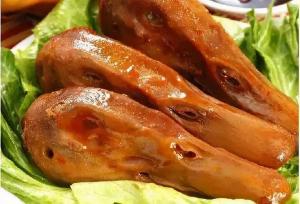
Can you imagine the taste of a duck head?
Other popular animal head dishes include:
1. Rabbit head with chili and wild pepper sauce/麻辣兔头/má là tù tóu 2. Griddled duck head with pepper/ 干锅鸭头/gàn guō yā tóu 3. Steamed fish head with diced hot red peppers/剁椒鱼头/duò jiāo yú tóu
Duck head originated from Changde in Dongting lake district of the Qing dynasty and spread in popularity to Sichuan and Hubei through Hunan. It is first soaked with a variety of spices, and then dried or baked. Duck head can be described as sweet, hot, salty, crispy and cottony, as well as having many other characteristics. The B vitamins and E vitamins found in duck heads are higher than many other foods. In addition, duck head contains rich nicotinic acid, which is one of the two important coenzyme components in the human body. It has a protective effect on heart disease and on patients with myocardial infarction.
3. Baked Sea Horse (烤海马 kǎo hǎi mǎ)
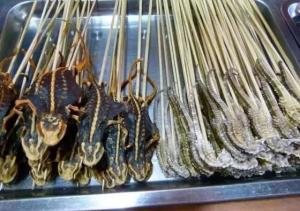
These teeny tiny animals of the ocean are highly sought after by scuba-divers. Turns out, all they have to do is come to a Chinese street market!
Sea Horses are thought to strengthen the body through strengthening kidneys, relaxing muscles, activating vessels, relieving inflammation and alleviating pain, calming nerves, relieving coughs and relieving asthma.
4. Deep Fried Scorpions (油炸蝎子 yóu zhá xiē zi)
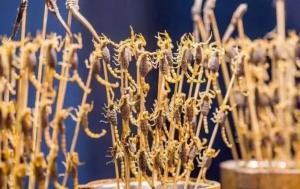
These big, black, creepy crawlies have been spotted in both Beijing and Hangzhou.
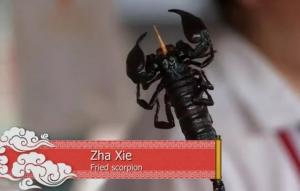
The origin of using scorpions in Chinese food can be traced back to the years of Kangxi. At that time the King of Mongolia was returning from a hunt and, smelling a tasty aroma as he passed through the backyards, he walked in and tasted the broth, “Wow, so delicious!” The cook told him it was scorpion soup and later, the soup spread in popularity to the rest of the population.
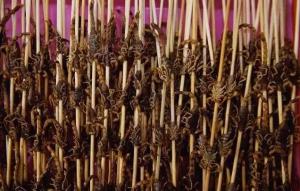
5. Drunken Shrimp(醉虾zuì xiā)
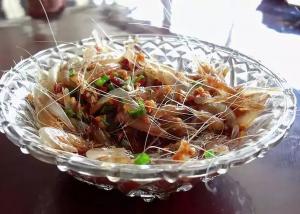
When I first read about drunken shrimp, I assumed the shrimp would be steamed in some delicious broth of wine and spices. The shrimp are indeed drunk, alive and swimming languidly through a pool of strong liquor. The eater is given the upper hand, as the alcohol slows down the movement of the shrimp. First, decapitate your victim, then pop the still wriggling body into your mouth.

Shrimp is rich in nutrients, and its meat is soft and easy to digest. It is an excellent food for those who are weak and need to be nursed after the illness.
Rich in magnesium, which has an important role in regulating heart activity. It can protect the cardiovascular system, reduce the cholesterol content in blood, prevent arteriosclerosis, and also expand the coronary artery, which is beneficial to prevent hypertension and myocardial infarction.
Similarly to milk, shrimp are rich in phosphorus and calcium, making them especially good for children.
6. Balut (毛蛋 máo dàn)
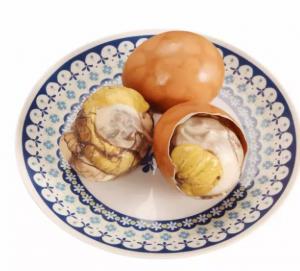
Baluts are pretty much like hard-boiled eggs, except the eggs are actually half-fertilized. This means that in Baluts, where you would usually find yolk, you instead find the partially developed fetus of a duck or chicken. Filipinos believe them to be aphrodisiacs and often eat them as a snack to accompany their beer.
Balut originated from South Asia. Gradually, in the Qing Dynasty, it became a Chinese snack. In Fujian, people also call balut ‘喜蛋 (xǐ dàn)’. It thought to be good for your brain, protect your liver, prevent arteriosclerosis.
7. Bee Larvae (蜂蛹 fēng yǒng)
Bee larvae are often eaten in Southern China thanks to their texture and nutritional value. Legend has it that Japanese emperor Hirohito’s favorite food was fried wasps over rice with a dash of sugar and soy sauce.
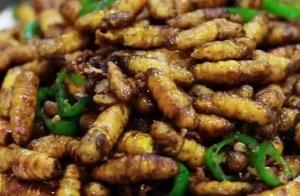
Decades ago, some areas of China had a shortage of food, they used bee larvae as a nutritional supplement to their diet. Bee larvae not only have a nice crunchy texture but are also full of protein.
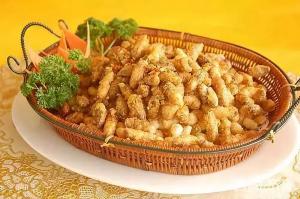
8. Sheep Penis (羊鞭 yáng biān)
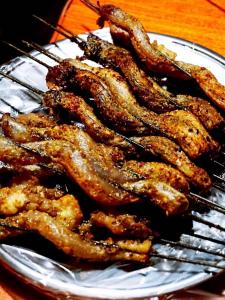
The penis is generally cooked by steaming or deep frying but can also be eaten raw. Some westerners compare the tastes of some penises with overcooked squid.
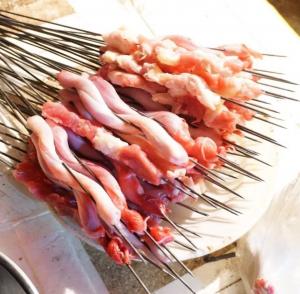
The origin of Sheep penises in food can be traced back to farmer’s autumn harvests, used to supplement their food, or to entertain friends and family with more unusual farm dishes. Because of its excellent taste, it is very popular with people in the city. Gradually, the whole sheep’s body became part of Chinese cuisine.
9. Deep Fried Sea Star (海星hǎi xīng)
I think some people must have tried this dish before, they are used for formal meals, or snacks, and are normally deep fried or baked.
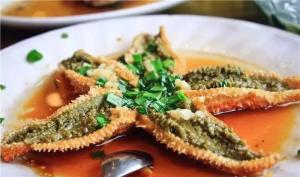
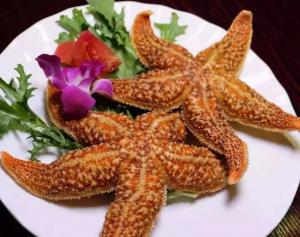
Benefits of eating Sea Stars are thought to include detoxification and loosening of knots; alleviation of stomach pain and acute diarrhea.
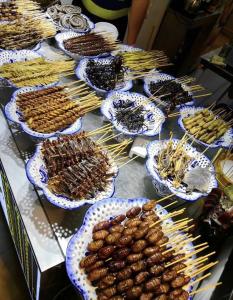
What other strange foods do you know?
Leave your comments below!